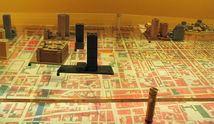Superblocks near Metro, Part 1: Prince George’s
Sprawl development comes with many impersonal, mobility-limiting, traffic inducing accouterments. Seven lane roads, grass berms, curb cuts, enormous setbacks, corporate drive-thru fast food restaurants, strip malls… the list is long and ugly. But perhaps the most basic symptom of poorly thought-out suburban planning is in the street grid: the superblock.
Superblocks destroy the permeability of the street networks, force large amounts of traffic onto arterial highways and virtually destroying the pedestrian environment. They breed excessive setbacks, and are often fronted by the omnipresent berm. Many of them house big box stores. They are often served by wide culs-de-sac that lead to acres of surface parking. And there are a surprising number of them adjacent to Metro.
When superblocks are present near Metro stations, they are veritable barriers to safe and consistent access. Though they may contain inroads, by definition the do not contain a tangible public route through them. This forces circuitous routes to the station or unsafe cut-throughs that may not be safe or legal.
I expected to find them in Prince George’s County. It is known for poor development around train stations. I did not expect to find them strung along entire routes, almost like an anti-transit-oriented development. But along the Orange and Blue Lines, such is the case.
The maps below show all the self-contained superblocks within approximately one mile of Metro stations.
View Superblocks PG Orange in a larger map.
View Superblocks PG Blue in a larger map.
I suppose one should not expect much better from an area that considers a concrete plant a wise use of real estate near an underused mass transit station.
The Green Line is no better. On the south side, the spaces between many of the stations are nothing but giant superblocks. A cul-de-sac neighborhood pod here, a shopping center pod there, all the while a failed opportunity to lay a continuous permeable street grid with coherent approaches to the stations, not to mention connecting residents to shopping to jobs.
Prince George’s County is not exactly known for its pedestrian safety, either. With a lack of safe approaches to stations, pedestrians are forced along roads like Branch Avenue, Silver Hill Road, and Auth Road, which have little design considerations for pedestrians. Here’s a look at southern leg of the Green Line:
View Superblocks PG Green South in a larger map.
The northern leg of the Green Line goes through many older communities in Hyattsville and College Park. Yet areas around the stations tend to be suburban blobs that neither embrace nor compliment the adjacent neighborhoods, which are traditionally laid out communities that have been there for over 100 years.
West Hyattsville is a veritable blank slate, with little development of any kind occurring near the station. Prince George’s Plaza still has a giant mall encased in parking hallmarking a long list of poor land use by the station. College Park, which is a larger regional transit center, has experienced little more than cookie-cutter office box development near the station. “Greenbelt” serves a relatively low density North College Park neighborhood and a surface parking lot suitable for landing military aircraft, but it has little coherent connection to the City of Greenbelt.
Instead of a string of pearls for TOD, it appears that the areas around Metro stations are pock marks on otherwise neatly planned areas, a truly absurd reversal of what you might normally expect in transit oriented areas:
View Superblocks PG Green in a larger map.
Infill construction along the existing Metro stations could profoundly affect the local economy. Breaking up the superblocks, tearing out the parking lots and cheap monolithic building complexes and replacing them with integrated communities with permeable street and pedestrian connections can make more economical use of the existing high-demand land, attracting jobs and residents.
Jobs and residents mean a greater tax base, which could go toward improving county schools, fighting crime, or cleaning up pollution. Until then, Prince George’s will continue to have some of the lowest ridership amongst its Metro stations, high pedestrian death rates, and lower property values than other areas near Metro.

